The demand for cassava bags in Japan is valued at USD 4.1 million in 2025 and is projected to reach USD 6.8 million by 2035, reflecting a CAGR of 5.3%. From 2025 to 2030, the market sees steady growth, with demand increasing from USD 4.1 million to approximately USD 5.3 million. This early growth reflects a growing consumer and business shift toward eco-friendly and biodegradable packaging solutions. The adoption of cassava bags continues to rise, particularly as industries seek sustainable alternatives to traditional plastic packaging in response to environmental regulations and changing consumer preferences.
The market experiences a noticeable shift in growth dynamics after 2030. From 2030 to 2035, demand reaches USD 6.8 million, reflecting a more significant acceleration in growth. This period marks the turning point in the adoption curve, where the use of cassava bags becomes more mainstream. The market sees rapid expansion driven by increased regulatory pressures to reduce plastic usage and heightened environmental awareness among consumers. The demand growth rate accelerates during this phase, indicating a clear breakpoint where sustainable packaging solutions gain traction and become more widely accepted across various industries. This momentum ensures continued demand for cassava bags through 2035.
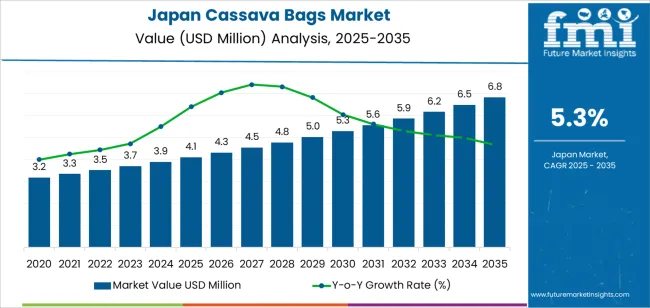
The market growth curve for Cassava Bags in Japan from 2020 to 2035 shows a steady and consistent upward trajectory, characterized by gradual increases in demand. From 2020 to 2025, the market expands from USD 3.2 million to USD 4.1 million, reflecting a moderate growth phase with a compound annual growth rate (CAGR) of 5.3%. This early phase represents the initial market acceptance, driven by increasing awareness and demand for sustainable packaging. The growth curve during this period remains smooth, with incremental improvements as cassava bags gain recognition for their environmental benefits.
From 2025 to 2030, the demand for cassava bags continues to grow at a steady pace, reaching USD 4.8 million. The growth curve remains consistent, indicating stable market development fueled by sustained interest in biodegradable products. The growth accelerates from 2030 to 2035, as the market reaches USD 6.8 million. The curve becomes steeper during this period, reflecting the increasing shift towards eco-friendly packaging solutions. Factors such as technological advancements in production, cost reduction, and growing regulatory pressures are expected to drive faster adoption of cassava bags. The overall growth pattern suggests a market on a clear upward path with sustained momentum and gradual acceleration as demand for sustainable alternatives increases.
| Metric | Value |
|---|---|
| Industry Value (2025) | USD 4.1 million |
| Forecast Value (2035) | USD 6.8 million |
| Forecast CAGR (2025 to 2035) | 5.3% |
The demand for cassava based bags in Japan has been driven by a historical rise in regulatory and consumer focus on reducing single use plastics. Japanese government policies promoting biodegradable and compostable packaging have encouraged adoption of alternative materials. Retailers and foodservice operators responded by trialing bags derived from cassava starch, leveraging Japan’s advanced machinery and printing infrastructure to deliver premium finishing. At the same time, growth in convenience store chains, e commerce packaging, and boxed meal deliveries created higher usage of lightweight carrier and packaging bags where cassava based options became viable. Supply chain collaborations between starch producers and Japanese converters also enabled cost optimisation.
Looking ahead, future growth in Japan is expected to be supported by further tightening of plastic bag regulations, expanded corporate commitments to circular packaging, and greater consumer preference for eco labelling. The rapid growth of online grocery fulfilment and ready made food delivery will increase demand for compostable bags. Innovation in cassava based films with improved strength, moisture barrier properties and full compost certification will broaden applications beyond shopping bags to packaging liners. Although challenges around cost competitiveness and raw material sourcing remain, Japan’s packaging industry is well positioned to scale cassava bag usage.
The demand for cassava bags in Japan is influenced by both the type and category of the bags. The primary types include grip-hole bags, T-shirt bags, and garbage bags, with grip-hole bags representing 38% of the total demand. The categories of cassava bags include organic and conventional, with organic bags leading the market at 59.1%. Organic bags are favored for their environmental benefits, aligning with the growing consumer demand for sustainable and biodegradable products. The type of bag chosen is typically dependent on the specific application, whether it be for retail, waste management, or other packaging purposes.

Grip-hole bags account for approximately 38% of the total demand for cassava bags in Japan. This high demand is primarily driven by their practicality and versatility in various applications, particularly in retail and grocery sectors. Grip-hole bags are favored for their durability and ease of handling, providing consumers with a convenient option for carrying groceries and other goods. Additionally, the growing emphasis on reducing plastic waste has increased the popularity of cassava-based alternatives, such as grip-hole bags, as they offer a biodegradable solution to traditional plastic bags.
The demand for grip-hole bags is also linked to their widespread use in Japan’s eco-conscious retail environment. As consumers and businesses alike seek more sustainable alternatives to plastic, cassava bags, including grip-hole designs, offer a practical and environmentally friendly option. The increasing focus on environmental sustainability in Japan, particularly in packaging and waste management, continues to drive the preference for cassava bags. As a result, grip-hole bags remain a dominant type in the growing market for sustainable, biodegradable packaging solutions.
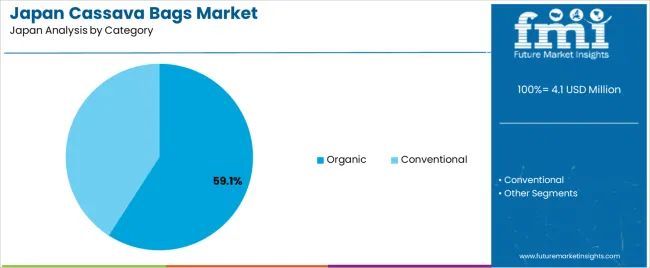
Organic cassava bags represent 59.1% of the total demand in Japan, reflecting the strong preference for sustainable, eco-friendly products. The growing consumer awareness of environmental issues, such as plastic pollution, has led to an increased demand for biodegradable alternatives like organic cassava bags. These bags are made from cassava starch, a renewable, plant-based material, which makes them an attractive option for consumers seeking to reduce their environmental impact. The demand for organic bags is particularly high in the retail and grocery sectors, where consumers are increasingly looking for products that align with their environmental values.
The demand for organic cassava bags is also driven by regulatory pressures and the desire for compliance with environmental standards. Japan has seen a rise in government policies promoting the reduction of plastic waste and encouraging the use of biodegradable packaging. These policies, along with growing consumer support for sustainable practices, have fueled the adoption of organic cassava bags. As sustainability continues to be a key consideration for consumers and businesses, the demand for organic cassava bags is expected to remain strong in Japan's packaging market.
The demand for cassava bags in Japan is influenced by regional regulatory reforms, consumer packaging preferences, supply chain constraints, and evolving market applications. Local policy moves to limit single use plastics and promote biodegradable alternatives act as growth drivers. At the same time, higher costs and manufacturing complexity present barriers. On the trend side, Japanese retailers and food service providers are exploring compostable bag formats from cassava starch for retail and e commerce channels. The interplay of these drivers, restraints and trends will determine how rapidly cassava based bag adoption proceeds in Japan.
Japan’s government initiatives to reduce plastic waste and promote biodegradable packaging have given impetus to alternative materials like cassava based bags. Retail chains in urban areas are adopting bio based carrier bags to meet consumer expectations and policy guidance. Increased awareness among Japanese consumers around plastic pollution has made eco friendly packaging a factor in purchasing decisions. These regulatory and retail packaging shifts are stimulating demand for cassava bags in food retail, convenience stores and delivery based e commerce settings.
In Japan, manufacturers of cassava bags face higher costs from importing cassava starch or biopolymer inputs and from limited domestic production scale compared with conventional plastics. The requirement to meet Japanese packaging standards including strength, printability and food safety certification adds manufacturing complexity. Lower domestic supply volumes mean higher per unit costs for producers supplying Japanese retailers. These cost and supply chain challenges restrict cassava bag usage primarily to premium applications rather than mass market segments for now.
Japanese consumers are increasingly looking for packaging that aligns with clean design aesthetics and clearly communicates environmental credentials. Retailers in Japan are experimenting with compostable carrier bags and bio derived packaging for fresh produce and e commerce delivery. The simplicity of cassava based bags, combined with clear messaging around biodegradability, resonates with urban Japanese shoppers. The growth of e commerce and home delivery for grocery and convenience items in Japan further elevates the importance of packaging formats like cassava bags that offer alternative branding opportunities while addressing waste concerns.
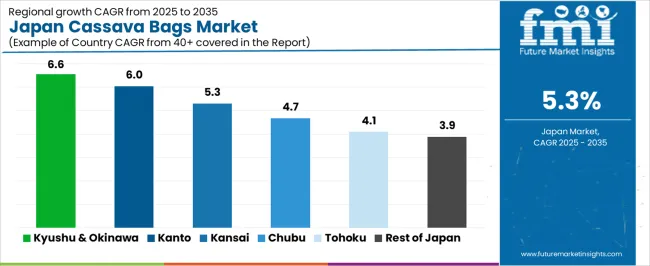
| Region | CAGR (%) |
|---|---|
| Kyushu & Okinawa | 6.6% |
| Kanto | 6.0% |
| Kansai | 5.3% |
| Chubu | 4.7% |
| Tohoku | 4.1% |
| Rest of Japan | 3.9% |
The demand for cassava bags in Japan is forecast to grow at varying rates across regions, with Kyushu & Okinawa achieving the highest CAGR of 6.6 %. This reflects the region’s increasing adoption of biodegradable packaging solutions and regional manufacturing initiatives. The Kanto region follows at 6.0 %, underpinned by strong consumer goods markets and sustainability driven packaging reform. In the Kansai region growth of 5.3 % is tied to regional retail and e commerce expansion.
The Chubu region’s 4.7 % CAGR reflects developing industrial use and supply chain adaptation. Tohoku at 4.1 % and the Rest of Japan at 3.9 % show slower uptake due to smaller market size and less concentrated packaging innovation. Overall the regional spread illustrates the declining gradient of adoption from high density urban and manufacturing hubs to more peripheral areas.
In Kyushu & Okinawa, the demand for cassava bags is growing at a CAGR of 6.6% through 2035. This growth is driven by increasing awareness of sustainable packaging solutions, especially in the food and retail sectors. As consumer preferences shift towards eco-friendly products, cassava bags are becoming more popular for packaging and distribution. The tourism industry in Okinawa, which increasingly focuses on eco-friendly initiatives, also plays a role in the rising demand. Additionally, local manufacturers are adopting cassava bags as a sustainable alternative to conventional plastic packaging.

In Kanto, the demand for cassava bags is projected to grow at a CAGR of 6.0% through 2035. As Japan's largest economic and industrial hub, Kanto is home to numerous businesses focusing on sustainable packaging solutions. The growing emphasis on reducing plastic waste, particularly in food and retail sectors, is driving the adoption of cassava bags. Major cities like Tokyo are seeing increased use of cassava bags for packaging in eco-conscious retail stores, food service outlets, and transportation. The region’s awareness of environmental impact continues to support this market growth.
In Kansai, the demand for cassava bags is expected to grow at a CAGR of 5.3% through 2035. The region's strong focus on eco-friendly packaging in retail, food, and agriculture sectors is contributing to the increasing adoption of cassava bags. Cities like Osaka are experiencing a growing shift towards environmentally responsible packaging, and cassava bags are becoming a key solution in this transformation. The local manufacturing and logistics industries are also incorporating cassava bags to meet sustainability goals and consumer preferences for green alternatives.
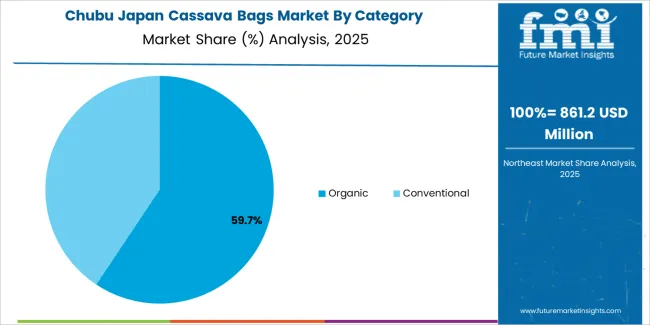
In Chubu, the demand for cassava bags is projected to grow at a CAGR of 4.7% through 2035. As the region's industries increasingly focus on sustainability, the demand for eco-friendly packaging like cassava bags is rising. The region’s robust agricultural and food production sectors are key drivers, with cassava bags being used for packaging agricultural products and food items. Additionally, Chubu’s growing retail and e-commerce markets are adopting cassava bags to meet the demand for sustainable packaging solutions among eco-conscious consumers.
In Tohoku, the demand for cassava bags is expected to grow at a CAGR of 4.1% through 2035. While Tohoku’s market is smaller compared to other regions, the growing demand for sustainable packaging in food, retail, and agriculture is driving the use of cassava bags. Local producers are increasingly adopting cassava bags to meet consumer preferences for environmentally friendly products. As the region’s agricultural industry continues to grow, the adoption of cassava bags in the packaging of food and produce is expected to rise, supporting overall market growth.
In the rest of Japan, the demand for cassava bags is projected to grow at a CAGR of 3.9% through 2035. As regional markets outside the major industrial centers continue to develop, demand for sustainable packaging solutions like cassava bags is rising. Local retail and food industries are increasingly adopting cassava bags as an alternative to plastic, responding to consumer preferences for environmentally responsible products. The growing awareness of environmental issues and the shift towards sustainable packaging are expected to drive steady growth in the use of cassava bags across these regions.
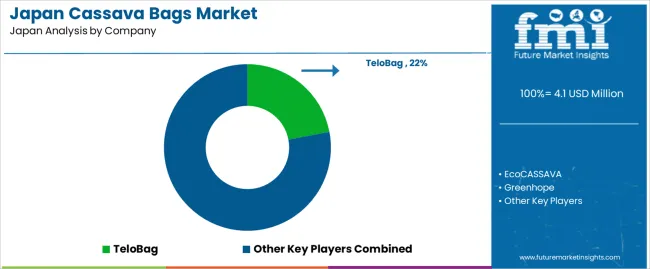
The demand for cassava bags in Japan is driven by the country’s increasing focus on sustainable packaging solutions and reducing plastic waste. As environmental concerns rise, consumers and businesses are seeking eco-friendly alternatives, leading to a growing adoption of biodegradable products like cassava bags. The Japanese government’s push for sustainable practices, including stricter regulations on plastic use, is also fueling the demand for renewable and biodegradable materials. Cassava bags, made from the starch of cassava plants, offer a renewable, biodegradable alternative to traditional plastic packaging, making them a popular choice in various sectors, including retail, food packaging, and logistics.
Key players like TeloBag, EcoCASSAVA, Greenhope, Nostraw Philippines, and ECOBALI are shaping the cassava bag market in Japan. TeloBag is a leader in the market, offering high-quality, biodegradable bags made from cassava starch, catering to the rising demand for environmentally friendly alternatives. EcoCASSAVA focuses on producing durable, sustainable packaging solutions that align with Japan’s eco-conscious consumer base.
Greenhope and Nostraw Philippines also contribute by providing cassava-based products aimed at reducing environmental impact. ECOBALI, known for its commitment to sustainability, is actively expanding its presence in the Japanese market, promoting eco-friendly packaging solutions. These companies play a crucial role in driving the growth of cassava bags in Japan through innovation and a shared commitment to reducing plastic waste.
| Items | Values |
|---|---|
| Quantitative Units (2025) | USD million |
| Type | Grip-Hole Bags, T-Shirt Bags, Garbage Bags |
| Category | Organic, Conventional |
| End Use | Food & Beverages, Animal Feed, Pharmaceuticals, Personal Care & Cosmetics, Others |
| Region | Kyushu & Okinawa, Kanto, Kansai, Chubu, Tohoku, Rest of Japan |
| Countries Covered | Japan |
| Key Companies Profiled | TeloBag, EcoCASSAVA, Greenhope, Nostraw Philippines, ECOBALI |
| Additional Attributes | Dollar by sales by type, category, end-use, and region; regional CAGR and adoption trends; volume and value growth projections; government regulations supporting biodegradable packaging; consumer demand for eco-friendly products; adoption across retail, food, and logistics sectors; production and cost optimization advancements; increasing shift towards circular packaging and compostable solutions; premium market adoption and growing awareness of environmental sustainability. |
The demand for cassava bags in Japan is estimated to be valued at USD 4.1 million in 2025.
The market size for the cassava bags in Japan is projected to reach USD 6.8 million by 2035.
The demand for cassava bags in Japan is expected to grow at a 5.3% CAGR between 2025 and 2035.
The key product types in cassava bags in Japan are grip-hole bags, t-shirt bags and garbage bags.
In terms of category, organic segment is expected to command 59.1% share in the cassava bags in Japan in 2025.






Our Research Products

The "Full Research Suite" delivers actionable market intel, deep dives on markets or technologies, so clients act faster, cut risk, and unlock growth.

The Leaderboard benchmarks and ranks top vendors, classifying them as Established Leaders, Leading Challengers, or Disruptors & Challengers.

Locates where complements amplify value and substitutes erode it, forecasting net impact by horizon

We deliver granular, decision-grade intel: market sizing, 5-year forecasts, pricing, adoption, usage, revenue, and operational KPIs—plus competitor tracking, regulation, and value chains—across 60 countries broadly.

Spot the shifts before they hit your P&L. We track inflection points, adoption curves, pricing moves, and ecosystem plays to show where demand is heading, why it is changing, and what to do next across high-growth markets and disruptive tech

Real-time reads of user behavior. We track shifting priorities, perceptions of today’s and next-gen services, and provider experience, then pace how fast tech moves from trial to adoption, blending buyer, consumer, and channel inputs with social signals (#WhySwitch, #UX).

Partner with our analyst team to build a custom report designed around your business priorities. From analysing market trends to assessing competitors or crafting bespoke datasets, we tailor insights to your needs.
Supplier Intelligence
Discovery & Profiling
Capacity & Footprint
Performance & Risk
Compliance & Governance
Commercial Readiness
Who Supplies Whom
Scorecards & Shortlists
Playbooks & Docs
Category Intelligence
Definition & Scope
Demand & Use Cases
Cost Drivers
Market Structure
Supply Chain Map
Trade & Policy
Operating Norms
Deliverables
Buyer Intelligence
Account Basics
Spend & Scope
Procurement Model
Vendor Requirements
Terms & Policies
Entry Strategy
Pain Points & Triggers
Outputs
Pricing Analysis
Benchmarks
Trends
Should-Cost
Indexation
Landed Cost
Commercial Terms
Deliverables
Brand Analysis
Positioning & Value Prop
Share & Presence
Customer Evidence
Go-to-Market
Digital & Reputation
Compliance & Trust
KPIs & Gaps
Outputs
Full Research Suite comprises of:
Market outlook & trends analysis
Interviews & case studies
Strategic recommendations
Vendor profiles & capabilities analysis
5-year forecasts
8 regions and 60+ country-level data splits
Market segment data splits
12 months of continuous data updates
DELIVERED AS:
PDF EXCEL ONLINE
Cassava Bags Market Growth – Demand & Forecast 2025 to 2035
Demand for Canvas Bags in Japan Size and Share Forecast Outlook 2025 to 2035
Japan Faith-based Tourism Market Size and Share Forecast Outlook 2025 to 2035
Japan Sports Tourism Market Size and Share Forecast Outlook 2025 to 2035
Japan Respiratory Inhaler Devices Market Size and Share Forecast Outlook 2025 to 2035
Japan Halal Tourism Market Size and Share Forecast Outlook 2025 to 2035
Japan Automated People Mover Industry Size and Share Forecast Outlook 2025 to 2035
Japan Automotive Load Floor Industry Analysis Size and Share Forecast Outlook 2025 to 2035
Japan Food Cling Film Market Size and Share Forecast Outlook 2025 to 2035
Japan Polypropylene Packaging Films Market Size and Share Forecast Outlook 2025 to 2035
Cassava Packaging Market Growth - Forecast 2025 to 2035
Japan Probiotic Yogurt Market is segmented by product type, source type, nature type, flavor type, fat content, sales channel and key city/province through 2025 to 2035.
japan Tortilla Market - Growth, Trends and Forecast from 2025 to 2035
Japan Cosmetics ODM Market Analysis - Size, Share & Trends 2025 to 2035
Japan Automotive Turbocharger Market Insights – Demand, Size & Industry Trends 2025–2035
Japan Yeast Market Insights – Demand, Size & Industry Trends 2025–2035
Japan Green and Bio-based Polyol Market Insights – Demand, Size & Industry Trends 2025–2035
Japan Natural Food Color Market Trends – Growth, Demand & Forecast 2025–2035
Japan Coated Fabrics Market Growth – Trends, Demand & Innovations 2025–2035
Japan Barite Market Growth – Trends, Demand & Innovations 2025–2035

Thank you!
You will receive an email from our Business Development Manager. Please be sure to check your SPAM/JUNK folder too.
Chat With
MaRIA